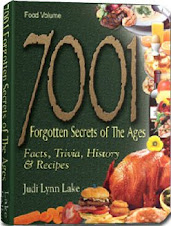
MANY OF THE MODERN AND DIVERSE foods we are familiar with and enjoy today were actually developed during a brief period of time from 1850 to 1900, much of which was promoted for its healthful properties and beneficial effects then, as it is today. Thus were the beginnings of what is referred to today as “nutritional science.”
Scientists (in concert to some extent with medical practitioners) began to realize the relationship between our health and the foods we eat. Further, exciting advances in analytical chemistry provided hard scientific data to prove it.
Recognizing the power behind the old adage, “you are what you eat,” food advertisers were quick to herald such news to a public that was open to learn about this “new” nutritional science. By 1901, food ads were calling attention to the “wholesomeness" and "healthfulness" of their food products. “Eat less meat and more Quaker Oats," and “Cereal leads to good health,” the American Cereal Company's ads proclaimed.
On the other hand, Dold's Packing Company, was adamant that their "corn-fed porkers made sweet healthful food." Vendors distributed literature and trading cards at markets and any venue where food was sold. They hired "barkers" at local fairs and events to sell their “healthy foods” in every way possible. The public was being effectively educated on the idea that healthy food products would make them feel better and live longer.
The result over time was that the general public became better educated in nutrition and, better yet, more discerning today of what constitutes genuinely healthful food.
CANNED AND PACKAGED FOODS
Ironically, as the emphasis on eating healthier food grew, so did the public's desire for quick and easy to serve processed food products. The late 19th Century saw the development of the canned meat and fruit industries— Libby's, Armour's, Van Camp, Borden and Heinz were the giants of the day. During this period saccharin, synthetic vanilla, and flaked cereal also entered the market, as well as the numerous soda pop brands, most of which are still sold today. The decade of the 1890s was an especially lucrative one for "quick food" producers with products like minute tapioca, "instant" cereal, condensed soup, and pre-ground coffee guaranteed to ease the labor of meal preparation.
The first metal cans/containers were patented by Englishman Thomas Kensett in 1825. While canned meats, fruits and vegetables were produced in America on a limited basis prior to the 1850s, the Civil War "created a significant need for portable foods to feed the troops and as a result, the canning industry rapidly expanded."
Opening canned foods was somewhat problematic until the invention of the can opener in the 1860s. Development of an opener was possible once cans were made of steel rather than iron.
The initial response to canned foods was one of skepticism and the age-old practice of "putting-up" preserves, fruits and vegetables at home continued in many middle-class kitchens. By the time the new century had arrived, hundreds of food products were being commercially prepared, and sales began to indicate that the American homemaker was accepting these new, convenient products. Not only did packaged goods bring economy to the kitchen in terms of time and convenience but the increased availability of fruits and vegetables all year round meant the family no longer had to dine according to what was in season.
THE BIRTH OF SOME POPULAR FOODS
1872: Blackjack Chewing Gum
1874: Ice Cream Soda
1876: Premium Soda Crackers (later Saltines)
1876: Hires Root Beer
1881: Pillsbury Flour
1886: Coca-Cola
1887: Ball-Mason Jars
1888: Log Cabin Syrup
1889: Aunt Jemima Pancake Mix
1889: Calumet Baking Powder
1889: McCormick Spices
1889: Pabst Brewing Company
1890: Knox Gelatin
1890: Libby Introduces Keys to Canned Meat
1890: Lipton Tea
1891: Del Monte
1891: Fig Newton
1891: Quaker Oats Company
1893: Cream of Wheat
1893: Good & Plenty
1893: Juicy Fruit Gum
1894: Chili Powder
1895: Shredded Coconut
1895: Triscuits
1896: Cracker Jack
1896: Michelob Beer
1896: S&W Canned Foods
1896: Tootsie Roll
1897: Campbell's Condensed Soup
1897: Campbell's Tomato Soup
1897: Grape Nuts
1897: Jell-O
1898: Nabisco Graham Crackers
1898: Shredded Wheat Cereal
1900: Coney Island Hot Dog
1899: Wesson Oil
1900: Chiclets Gum
1900: Cotton Candy
1900: Hershey's Chocolate
###
The following video, Coca-Cola Natal Christmas 1944-1973 - 2007, courtesy of You Tube.
***





 Stumble It!
Stumble It!


No comments:
Post a Comment